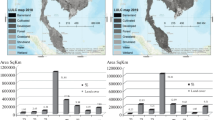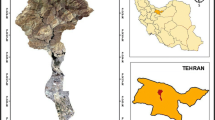Abstract
Detection of land use/land cover with the help of satellite image data and extraction of geographical features is a challenging problem as it requires continuous monitoring and accurate processing of the images. For environment change management, Land Use Land Cover (LULC) information plays a vital part. This paper proposes a way for the detection of LULC types such as buildings, vegetation, water bodies, etc. with the use of Landsat 7 multispectral satellite images in Sabarmati Riverfront region, Ahmedabad, India. Landsat images have become valuable as well as a free resource as it provides the factors like high resolution, temporal distribution, and availability for the detection of LULC. Further, the use of the QGIS tool based Maximum/Minimum likelihood classification helps to explore and object-based image classification. Thus, Continuous monitoring over the same area will give the difference of LULC resulting in rapid or slower growth of land cover land use region. The proposed method gave a high rate of success and approximate 70–80% accurate results of LULC over period of 2014–2022.











Similar content being viewed by others
Data Availability
The data that support the findings of this study are processed and extracted from USGS Earth Explorer.
Code Availability
The datasets generated during and/or analyzed during the current study are available from the corresponding author on reasonable request.
Abbreviations
- CAD:
-
Channel-attention-based densenet
- CNN:
-
Convolutional neural networks
- DHFF:
-
Deep homogeneous feature fusion
- ETM+:
-
Enhanced thematic mapper
- FCM:
-
Fuzzy C-means
- GF:
-
Gaofen which means high-resolution in Chinese
- IST:
-
Image style transfer
- LiDAR:
-
Light detection and ranging
- LULC:
-
Land use land cover
- MLC:
-
Maximum likelihood classification
- MLE:
-
Maximum likelihood estimation
- NASA:
-
National aeronautics and space administration
- NDII:
-
Normalized difference infrared index
- NDVI:
-
Normalized difference vegetation index
- OSM:
-
Open street map
- PAN:
-
Panchromatic range
- QGIS:
-
Quantum geographic information system
- RBF-SVM:
-
Radial basic function support vector machine
- RF:
-
Random forest
- RGB:
-
Red green blue
- ROI:
-
Region of interest
- SAE:
-
Stacked auto encoder
- SAR:
-
Synthetic aperture radar
- SCP:
-
Semi-automatic classification plugin
- SR:
-
Standard deviation of the structure
- SWIR:
-
Shortwave infrared
- TIFF:
-
Tagged image file format
- TIR:
-
Thermal infrared range
- UAV:
-
Unnamed aerial vehicle
- USGS:
-
United States geological survey
- VNIR:
-
Visible and near infrared
References
Zhou, Z., & Gong, J. (2018). Automated residential building detection from airborne LiDAR data with deep neural networks. Advanced Engineering Informatics, 1(36), 229–241.
Aamir, M., Rahman, Z., Pu, Y. F., Abro, W. A., & Gulzar, K. (2019). Satellite image enhancement using wavelet-domain based on singular value decomposition. International Journal of Advanced Computer Science and Applications, 10(6).
Chen, D., Shang, S., & Wu, C. (2014). Shadow-based building detection and segmentation in high-resolution remote sensing image. Journal of Multimedia, 9(1), 181–188.
Gunawan I, Kusumaningrum DE, Triwiyanto T, Zulkarnain W, Nurabadi A, Sanutra MF, Rosallina NS, Rofiq MA, Afiantari F, Supriyanto KP, & Yuantika EA. (2018). Hidden curriculum and character building on self-motivation based on k-means clustering. In 2018 4th international conference on education and technology (ICET) (pp. 32–35). IEEE.
Zeng, P., Sun, F., Liu, Y., Tian, T., Wu, J., Dong, Q., Peng, S., & Che, Y. (2022). The influence of the landscape pattern on the urban land surface temperature varies with the ratio of land components: Insights from 2D/3D building/vegetation metrics. Sustainable Cities and Society, 1(78), 103599.
Zhao, F., Fan, J., & Liu, H. (2014). Optimal-selection-based suppressed fuzzy c-means clustering algorithm with self-tuning non local spatial information for image segmentation. Expert systems with applications, 41(9), 4083–4093.
Cai, G., Ren, H., Yang, L., Zhang, N., Du, M., & Wu, C. (2019). Detailed urban land use land cover classification at the metropolitan scale using a three-layer classification scheme. Sensors, 19(14), 3120.
Noronha, S., & Nevatia, R. (2001). Detection and modelling of buildings from multiple aerial images. IEEE Transaction on Pattern Analysis and Machine Intelligence, 23, 501–518.
Prathap, G., & Afanasyev, I. (2018). Deep learning approach for building detection in satellite multispectral imagery. In 2018 international conference on intelligent systems (IS) (pp. 461-465). IEEE.
Killeen, J., Jaupi, L., & Barrett, B. (2022). Impact assessment of humanitarian demining using object-based peri-urban land cover classification and morphological building detection from VHR Worldview imagery. Remote Sensing Applications: Society and Environment, 1(27), 100766.
Phiri, D., & Morgenroth, J. (2017). Developments in landsat land cover classification methods: A review. Remote Sensing, 9(9), 967.
Al Furjani A, Younsi Z, Abdulalli A, Elsaeh M, Almahdi A, Jouili K, & Lashihar SB. Enabling the city information modeling cim for urban planning with openstreetmap OSM.
Ben Abbes, A., & Jarray, N. (2022). Unsupervised self-training method based on deep learning for soil moisture estimation using synergy of sentinel-1 and sentinel-2 images. International Journal of Image and Data Fusion, 3, 1–4.
Tong, W., Chen, W., Han, W., Li, X., & Wang, L. (2020). Channel-attention-based DenseNet network for remote sensing image scene classification. IEEE Journal of Selected Topics in Applied Earth Observations and Remote Sensing., 15(13), 4121–4132.
Zhou, S., Xue, Z., & Du, P. (2019). Semisupervised stacked autoencoder with cotraining for hyperspectral image classification. IEEE Transactions on Geoscience and Remote Sensing, 57(6), 3813–3826.
Rottensteiner, F., Sohn, G., Gerke, M., Wegner, J. D., Breitkopf, U., & Jung, J. (2014). Results of the ISPRS benchmark on urban object detection and 3D building reconstruction. ISPRS Journal of Photogrammetry and Remote Sensing, 93, 256–271.
Tomljenovic, I., Höfle, B., Tiede, D., & Blaschke, T. (2015). Building extraction from airborne laser scanning data: An analysis of the state of the art. Remote Sensing, 7, 3826.
Wang, R., Peethambaran, J., & Chen, D. (2018). LiDAR point clouds to 3-D urban models: A review. EEE Journal of Selected Topics in Applied Earth Observations and Remote Sensing, 11, 606–627.
Funding
The work includes no funding support.
Author information
Authors and Affiliations
Corresponding author
Ethics declarations
Conflict of interest
The Author(s) declare(s) that there is no conflict of interest.
Additional information
Publisher's Note
Springer Nature remains neutral with regard to jurisdictional claims in published maps and institutional affiliations.
Rights and permissions
Springer Nature or its licensor (e.g. a society or other partner) holds exclusive rights to this article under a publishing agreement with the author(s) or other rightsholder(s); author self-archiving of the accepted manuscript version of this article is solely governed by the terms of such publishing agreement and applicable law.
About this article
Cite this article
Lavanya, K., Gondchar, A., Mathew, I.M. et al. Land Cover Classification Using Landsat 7 Data for Land Sustainability. Wireless Pers Commun 132, 679–697 (2023). https://doi.org/10.1007/s11277-023-10631-w
Accepted:
Published:
Issue Date:
DOI: https://doi.org/10.1007/s11277-023-10631-w




